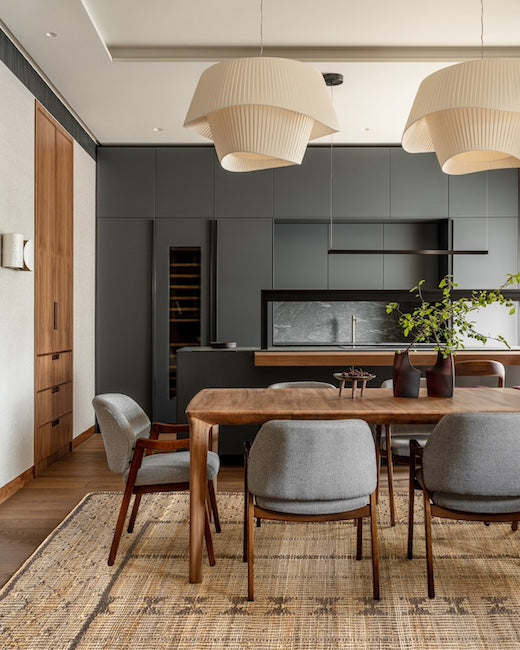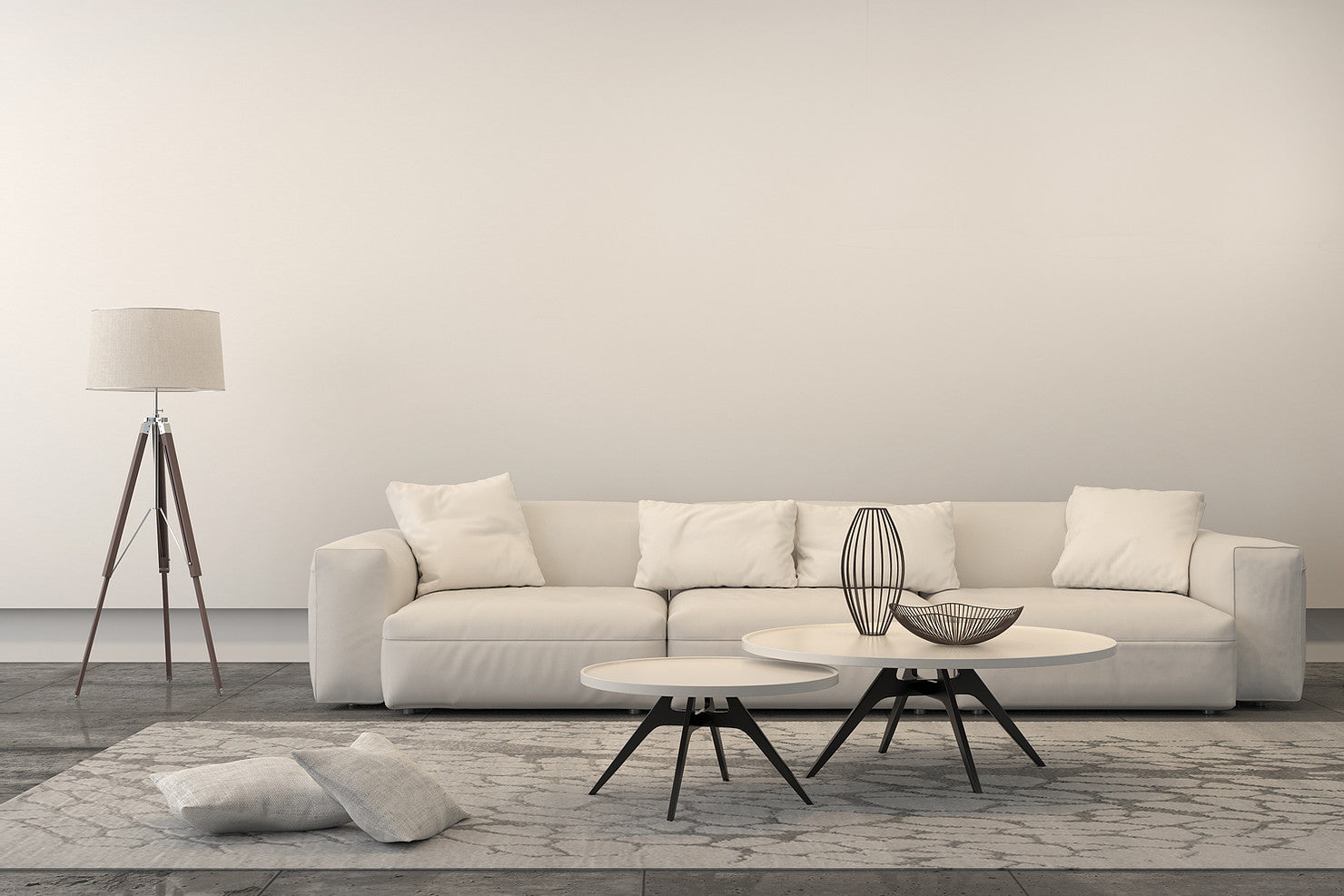
Rug Glossary
Abrash
Differences in the colour and porosity of the natural wool can result in gentle colour variations within each finished rug. This subtle, desirable shading is often most noticeable in large areas of saturated colour and in areas woven from pale, undyed fibres.
Colour Variation
All our woven pieces are handcrafted using ancient dyeing techniques. The Australian Standards for dyed wool allow for a 5% variation in colour and slightly more for natural fibres, such as jute and pure wool. This is part of the beauty of handmade rugs. Please inspect and select the item that resonates with you.
Dyes
Many of our rugs are woven using undyed natural fibres. When we choose to add colour, we use premium quality dyes. These provide the best looking and most colourfast option while being free from harmful benzene.
Flat-Weave
Our rugs are woven using techniques passed down through the generations. Flat-weave rugs are crafted on a loom where the weft is tightly intertwined with the warp. The resulting rug is flat, without pile or knots.
Flattening
This occurs when areas of the rug are under pressure from heavy traffic or from being under furniture. Flattening is easily remedied with a quick vacuum. Gentle hand cleaning will also add a little moisture and help to plump the rug back up.
Hand Binding
Our woven rugs feature hand binding. This hand-stitched overlocking adds a neat, straight finish to the edges and enhances the durability of the rug. Hand binding also helps the rugs to lie flatter on the floor, improving their appearance and safety.
Hand-knotted
Hand-knotted rugs are crafted on a vertical loom where knots are deftly tied to each warp strand in between the warp. This age-old technique is time-consuming but the intricate nature of its construction means that hand-knotted rugs are very strong and can last for decades if properly cared for. A hand-knotted rug is not to be confused with a hand-tufted rug, which is made using a mechanised tufting gun that shoots yarn into a backing cloth. Hand-tufted rugs are very quick to make and therefore more affordable but are not nearly as hardwearing as a hand-knotted alternative.
Handmade
We take pride in the fact that all of our rugs are crafted by hand. Our artisans weave each rug using looms with manual or foot-operated gears to raise and lower the warp strands. For hand-knotted rugs, artisans tie single knots to each warp on a traditional vertical loom. We use no mechanisation except for the zigzag stitching on the Braid rug, which is done with a manual sewing machine. The resulting rugs have subtle variations in character that add to their beauty. The handmade process is more environmentally friendly causing fewer carbon emissions and allows our artisans to work from home instead of in a factory to supplement their farming lifestyle.
Heddle
Each warp strand of the loom is controlled by a heddle. This cord or wire separates and guides the warp threads, making a path for the shuttle as it weaves across the loom. Depending on the size and weave style of the rug, our artisans may work with thousands of heddles on the loom.
Jute
Jute is an extremely strong, durable and environmentally friendly fibre, which develops a lovely lustre when spun into yarn. It also offers anti-microbial properties and is fire retardant.
Latex Backing
Made from natural rubber, this anti-slip product is painted onto the underside of the rug for added surface grip, strength and durability. It is something we highly recommend for stability and non-slip factor, especially for hallway runners, smaller rugs, round rugs and lighter weaves.
Loom
Our artisans have a long tradition of loom weaving. A loom is essentially a large frame that holds the warp strands tight so the weft strands can be passed under and over. Depending on the weave, our artisans work using either a floor, vertical or pitt loom.
Loom Binding
This is the neat, straight side finish of the rug, which results directly from the loom as part of the weaving.
Maintenance
There are a few general guidelines you can follow to keep our rugs looking their best and ageing well: vacuum regularly, rotate rugs end-to-end to allow them to wear more evenly, immediately remove and clean stains or spills following our tips in the FAQ section of our website. When in doubt regarding damage, please contact a professional.
Monsoon
Monsoon season is characterised by strong seasonal winds and heavy rain. Lasting from May to September, it can slow down our rug production as many of the processes, such as drying and finishing, are done outdoors.
PET Fibre
This is a polyester fibre made from recycled plastic bottles. PET fibre is extremely durable and feels surprisingly soft underfoot. We source ours locally in India.
Pop-Ups
Due to the type of weaving, there may be short fibres popping up while the rug settles. These pop-ups can be carefully trimmed or pushed through without affecting the integrity of the weave.
Runner
This is a long, narrow rug used mostly for hallways. Our runners come in standard sizes or can be custom made to specific measurements. We do not recommend using our runners on staircases.
Soumak
This is a flat weave style where the yarn is wrapped around the warp to create a ‘knitted’ appearance.
Shedding
With rugs crafted from all-natural material, it is normal to see a slight loss of rug fibres or shedding. The amount depends on the usage of the rug. This initial settling in period will taper off over time and can be helped along with regular vacuuming.
Shuttle
A shuttle is used by our weavers to carry the weft strands back and forth between the warp threads.
Side Binding
This can be loom or hand binding which gives a neat, straight finish to the edges and enhanced durability of the rug.
Storing
To store your rug, we recommend you roll it with the backing showing and wrap it in cloth for storage protection. Our rugs are made with natural fibres and need to breathe and lie relatively flat. Please do not store them in an airtight plastic cover or folded.
Tassels
Tassels are created when the warp threads are knotted together to extend beyond the ends of a rug. While some of our rugs feature tassels, many are finished with a hand-stitched turnover that hides these warp threads.
Treadle
These are the foot or hand-operated levers under the loom that raise and lower the heddles as one. The treadle is also known as the gears.
Turnover
This is a neat finish to the shorter ends of a rug, which is created by turning over the woven warp ends and hand sewing them into place.
Underlay
To provide added safety, softness, noise reduction and wear protection, we recommend the use of a non-slip felt underlay beneath the rug.
Warp
These are the vertical strands of yarn that run the entire length of the rug and form the frame onto which the weft is woven. Our artisan weavers use different arrangements of warp threads to create various patterns.
Warp Beam
The warp beam is the foot-operated roller at the back of the loom that raises and lowers the heddles.
Weave
Weave describes the particular way the warp and weft strands interlace. Using different warp and weft arrangements as well as gearings, our weavers are able to create different weave patterns.
Weaver
Our weavers are our extended family. These talented artisans create the rugs by hand on a loom, carrying on knowledge and traditions passed down through generations.
Weaver’s Knot
A weaver’s knot is used to join two threads together, for instance when a warp thread breaks. It produces a small knot that can pass through the heddles in order to continue weaving. Weaver’s knots are usually so fine as to be unnoticeable in the finished rug.
Weft
This is the yarn that runs the width of the rug. The strands of weft are woven over and under the warp to create the body of the rug. The weft produces each rug’s colour and contributes to patterning.
Wool
While wool often refers to natural fibres spun from the hair of different animals, we use sheep wool that is sourced from a variety of countries including New Zealand, India, Argentina and Europe, depending on the overall finish of the rug. New Zealand wool provides more brilliant dyeing opportunities and is slightly softer underfoot. Indian wool has beautiful natural colour variations and provides a slightly more matte finish.
Yarn
The spun fibres used for weaving are known as yarn. We use all-natural sustainable fibres, such as wool, cotton and jute, for our indoor rugs, and recycled PET yarn for our Indoor Outdoor Collection.





Leave a comment
This site is protected by reCAPTCHA and the Google Privacy Policy and Terms of Service apply.